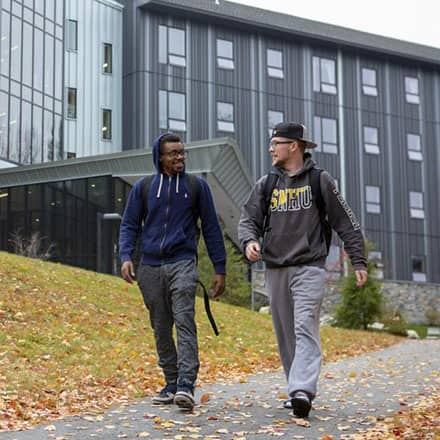How to Work From Home and Stay Engaged
For the last few years, remote work has been on the rise. Shifting workforce demands, changing employee needs and advancements in technology have all sparked conversations about where and how we do work. For 43% of Americans, remote work is simply how work is done. Whether you’ve always wanted a remote work experience or have found yourself suddenly thrust into a remote position, it can take a bit of reorganization – for both your workspace and your mindset – to find your groove.
Five seasoned remote employees from Southern New Hampshire University (SNHU) shared their experiences with transitioning from face-to-face to remote and how they stay engaged as members of the remote workforce.
Staying Engaged Through Peer Interaction

Reaching out to peers is also one of the ways that she stays engaged. When reflecting on the remote environment, Thomas said, “I am more productive, creative, and have become more of an extrovert in the process.” To maintain her engagement levels, “I ask questions, pay attention to the ‘happenings’ at SNHU, such as events, or professional development opportunities,” she said.
Weekly Wellness and Regular Check-ins

Half of her team is remote – and she draws on her own experience in leading her team. “I appreciate the support I received from my team lead and having regular check-ins to make sure I was adjusting well,” Humkar said. So, she developed weekly wellness sessions for remote team members.
One of Humkar’s strategies for staying engaged includes technology. She said she’s able to connect with anyone at SNHU with the click of a button. “I encourage you to take advantage of this. Schedule regular meetings with team members and leadership inside and outside of your team,” she said. “Join committees so you can stay connected with your company and continue to grow in your role.”
Leveraging Chat Tools

To help her feel productive, Fifer created a dedicated working space so that she could have a sense of going to work each day. She leverages several communication tools to stay engaged. “We use webcams in every meeting, hold weekly staff meetings and huddles and use group chat,” Fifer said. If people are unable to attend the meetings, they record them so everyone has access to the information shared in meetings regardless of location or shift.
While she can’t walk from desk to desk to say hello, she uses chat tools to send a quick hello to coworkers and connect with other informally. “Since I can’t walk to the cafeteria, I take a virtual stroll and connect with partners for coffee chats online,” Fifer said. She also suggests helping others find you by updating your status to reflect availability on chat or phone tools.
Keeping the Camera On

When it comes to staying engaged as a remote employee, Rogers uses a few approaches. “I try to be on ‘optional’ calls. I find this to be a great way professionally to engage and have some ‘face time’ with others,” she said, and always turns on her camera so video calls can replicate a face-to-face conversation.
Rogers said she’s active in social media and tries to stay up to date with what’s happening at SNHU’s Manchester, New Hampshire, Millyard offices and make connections with her colleagues, remote and onsite.
Communicating Regularly to Avoid Isolation

Given he had the freedom to work from anywhere, Tautenhan quickly learned he was better off at his home office. “I’ve found that doing this (working outside his remote office) once in a while was good but can lead to distraction and less efficiency,” he said.
Working remotely can sometimes feel isolating, Tautenhan said, noting the importance of communicating with others. “Having normal conversations about life, the news and checking in with my coworkers, family and friends helps me feel connected, supported,” he said.
By plugging into multiple communication channels, Tautenhan said he can stay up-to-date on things that are happening around the organization. His team has weekly calls to catch up on activities for the week, and he regularly checks on university news – external and within the employee portal, as well as LinkedIn.
Be Patient and Stay Engaged
The shift from face-to-face to remote work is different for everyone. For some, it’s a seamless transition, and for others, it can take some time to adjust. “There is a learning curve but be patient. Once you find your rhythm, you will see everything fall into place,” Humkar said.
Our remote pros have offered some great tips for staying engaged no matter where your day-to-day work takes you. Think about what strategies you’ll employ and the support structures you need to create conditions for you to bring your best selves to work, regardless of the location.
Dr. Shanita Williams has been focused on the employee experience for the last 10 years. She is currently the associate vice president of Talent Engagement and Inclusion within the Human Resources department. In her role, she collaborates with leaders across the university to drive employee engagement and ensure that inclusion is embedded in all of our talent strategies, initiatives and programs. Her area of expertise includes: Emotional Intelligence (EQ), DiSC, Limiting Beliefs, Change Management, Coaching, and Feedback. Williams earned her Doctorate in Educational Leadership, where her research focused on the lived experiences of working mothers as students.
Explore more content like this article

How to Reinvent Yourself

Best Careers for Creative People

Students, Alums Strengthen Skills Through Black History Month Projects
About Southern New Hampshire University

SNHU is a nonprofit, accredited university with a mission to make high-quality education more accessible and affordable for everyone.
Founded in 1932, and online since 1995, we’ve helped countless students reach their goals with flexible, career-focused programs. Our 300-acre campus in Manchester, NH is home to over 3,000 students, and we serve over 135,000 students online. Visit our about SNHU page to learn more about our mission, accreditations, leadership team, national recognitions and awards.


